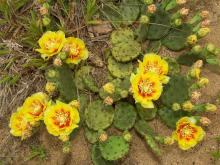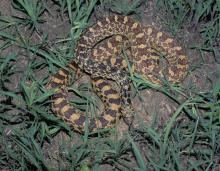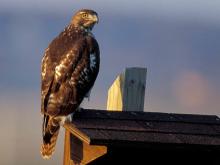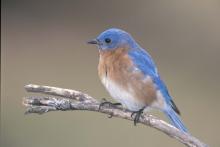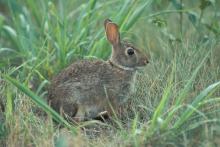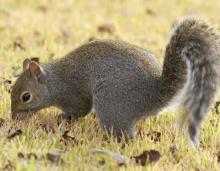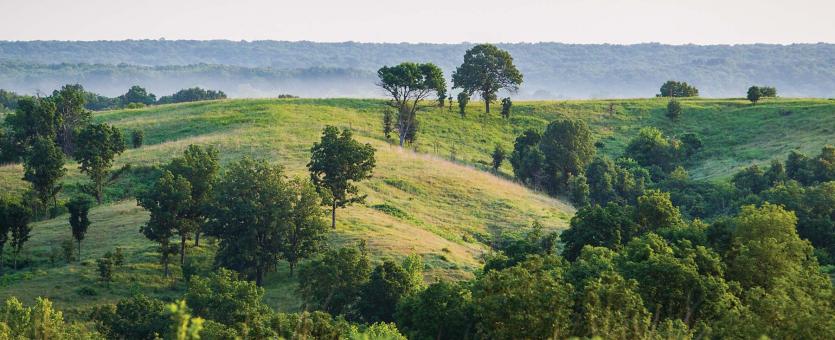
Only a handful of savanna landscapes remain in Missouri, surviving where prairies transition into woodland. Our native grasslands provide essential habitat for many plant and animal species. For a general introduction to this community type, see Grasslands, Prairies, and Savannas in Related Habitats below.
Savannas Are Distinctive
They look like native prairies, but savannas also have some trees. By definition, savannas have trees that are widely spaced, with usually no more than 30 percent canopy cover. Savannas generally exceed 20 acres in size, and the open-grown, mature trees often have wide-spreading branches. Thus savannas have an open, parklike look. Sometimes they are said to resemble orchards. The trees can occur in assorted groupings of various-aged trees, or as stand-alone trees.
What Makes A Savanna?
Savannas are transitional between prairie and woodland. All three of these habitat types have a robust groundcover of native perennial grasses and forbs (soft-stemmed wildflowers), and all three are disturbance-adapted. Without occasional disturbance, such as fire or grazing, to inhibit the encroachment of trees and other woody plants, they will eventually turn into forest, a habitat covered 100 percent by tree canopy. The different coverage of woody species — none for prairies, up to 30 percent for savannas, and 30 to 100 percent for woodlands — usually reflects the severity and frequency of fires, which in turn varies due to differences in topography and moisture.
For thousands of years, our native prairies, savannas, and woodlands were kept open by natural and human-caused fires. Whether caused by lightning or by people, fires prevented trees and shrubs from getting established, while the same flames cleared the accumulated thatch of perennial grasses and forbs, fertilizing and rejuvenating them.
Savanna Subtypes
Several subtypes of savannas have been designated in Missouri, based on soil moisture and substrate material. Because nearly all of them have been eliminated from the state, these are described in the past tense. Thanks to detailed records made by land surveyors and others prior to European settlement, we have a good idea of what Missouri’s historic savannas looked like and where they were located.
1. Dry-mesic loess/glacial till savanna once occurred in large patches of 100 to 1,000 acres across much of northern Missouri, with smaller patches along the eastern border. Widely spaced, open-grown bur oaks, white oaks, shingle oaks, and other trees with wide-spreading limbs gave an orchardlike look to the summits, broad ridges, and backslopes of broad plains dominated by mixed grasses and forbs. Today, remnants of this savanna type have turned into closed bur oak forests in northern Missouri. Representative remnant sites include Chariton Hills Natural Area, Long Branch State Park, and Spring Creek Ranch Natural Area.
2. Mesic loess/glacial till savanna once occurred in small patches of less than 100 acres in roughly the same region as above, but usually on lower, strongly sloping backslopes, accounting for the additional moisture in the soils and increased soil fertility — creating a lusher, taller soft-stemmed plant community than the drier situation described above. Today, remnants of this savanna type have turned into closed bur oak forests in northern Missouri. A representative site is the Union Ridge Conservation Area.
3. Limestone/dolomite savanna had a vegetative structure similar to the above types, but it occurred, in small and large patches, in western and southwestern Missouri on limestone/dolomite substrates, on the Springfield Plain, White River Hills, and nearby areas. The prevalent trees were chinquapin oaks and post oaks, and the groundcover was dominated by sideoats grama, big bluestem, and a sedge (Carex meadii). Fragrant sumac and Carolina buckthorn were characteristic shrubs. This savanna type was much like the nearby limestone/dolomite prairies and dolomite glades (another transitional type of natural community between grassland and woodland). Today, remnants of this savanna type have degraded into closed post oak, chinquapin oak, and red cedar woodlands. Representative sites to see possible remnants include Big Creek Basin, along the Glade Top Trail in the Mark Twain National Forest, and Drury-Mincy Conservation Area.
4. Chert savanna had the same two-layered plant community as other savannas, consisting of mature single trees or groups of trees with a prairie-like groundcover. It occurred, in large and small patches, mainly in the southern half of the state, associated with dry-mesic chert prairie. Dominant trees were post oak, blackjack oak, black oak, and black hickory. Soft-stemmed plants included big and little bluestem, Indian grass, scaly blazing star, pasture rose, naked-stemmed sunflower, and royal catchfly. Today, remnants of this savanna type have degraded into closed post oak woodlands due to prolonged grazing history and invasion by woody plants. Apparently, no representative sites remain. Remnant sites may yet be searched for and identified, and carefully managed for restoration.
5. Sandstone/shale savanna occurred in medium-sized patches mostly in the Cherokee Plain, and in smaller patches in the Osage Plains and Ozark Highlands, in southwestern Missouri. It was associated with adjoining dry-mesic sandstone/shale prairie, and the two share groundcover species, including big and little bluestem, Indian grass, bigflower coreopsis, and Sampson’s snakeroot. Dominant trees include post and blackjack oaks, black hickory, and winged elm. Other plants include lead plant, New Jersey tea, and pasture rose. Today, remnants of this savanna type may still exist because the shallow, rocky soils it occurs on are not suitable for cultivation. A representative site is Dave Rock Natural Area.
6. Sand savanna occurred in large patches in Missouri’s Bootheel, and like other habitats in that region, it is quite distinctive from the rest of our state. It occurred on natural levees, elevated sand ridges, and ancient terraces made of river-borne substrates. Soils are sandy, deep, and well-drained, with low fertility. This habitat is closely related to nearby sand woodland and sand prairie. Notable trees include post and blackjack oaks and black and mockernut hickories. The groundcover includes little bluestem, plains puccoon, rushfoil, eastern prickly pear, field cottonweed, umbrella sedge, and fall witchgrass. Catbrier is common, too. Today, only a few disjunct and highly disturbed remnants of sand savanna remain, mostly on elevated sand ridges and knolls. The rest has been nearly eliminated by conversion to agriculture and grazing. Representative sites — there are just a few remaining examples — are on private lands on the Sand Ridge in Scott County.
How Much Savanna Is Left?
In recent years, ecologists have fine-tuned their thinking about our disturbance-adapted habitats, refining their definitions of prairie, savanna, woodland, and forest. Obvious differences in structure of the plant communities, topography, and species composition support this revision, which is now widely accepted. Before the revision, savanna was defined as having 10 to 50 percent wooded cover, but now, many of those habitats are considered woodland (which is defined now as having 30 to 100 percent cover). Thus the estimated amount of presettlement savanna has decreased a great deal. Using the definitions used in the 1980s, presettlement savanna covered perhaps 13 million acres, but using today’s definitions, this has been revised to 6.5 million acres (the rest being reclassified as open woodland).
Any way you define it, there is very little savanna left. Some fragmented samples of former savannas are known to exist in our state. Many savannas today are masked by dense stands of trees that have grown up in the absence of fire, or their soft-stemmed groundcover layer has been converted to cropland or pasture.
Plants and Animals
Because savannas are basically a blend of grassland and woodland habitat, the species that live in savannas represent a blend of those community types. The species that live in savannas tend to be habitat generalists or “edge species” that can exploit characteristics of both grassland and woodland habitats. As the percentage of woody cover versus open area changes, the types of plants and animals shift.
Compared to nonnative, altered grasslands (such as pastures and old fields), savannas, like prairies, have a staggering diversity of plant species, even on a relatively small patch of land. With so many types of plants, a large variety of animals are supported, too.
Animals
Most savanna animals live in almost any habitat that includes a border between a grassy, open area and a wooded area. Nuts and fruits are abundant in healthy savannas, and these acorns, hickory nuts, blackberries and other fruits provide food for many animals.
Mammals that inhabit savannas include white-tailed deer, coyote, gray fox, eastern cottontail, eastern fox squirrel, and white-footed mouse. Historically, bison, elk, and gray wolf were abundant in savannas, but those were all extirpated from our state.
The Indiana myotis, a federally endangered bat, is highly associated with savannas and open woodlands. This bat spends winter in caves, but in summer females give birth to their young beneath the bark of live and dead trees or in tree cavities, forming breeding colonies containing up to several hundred individuals. These maternity colonies apparently develop both primary and alternative roost sites, using slightly different microhabitats, depending on temperature and precipitation.
Birds associated with savannas include red-tailed hawk, American kestrel, wild turkey, red-headed woodpecker, willow flycatcher, great crested flycatcher, scissor-tailed flycatcher, loggerhead shrike, white-eyed vireo, Bell’s vireo, warbling vireo, blue jay, bewick’s wren, brown thrasher, blue-winged warbler, prairie warbler, yellow-breasted chat, lark sparrow, northern cardinal, blue grosbeak, rose-breasted grosbeak, indigo bunting, orchard oriole, Baltimore oriole, American goldfinch, and eastern bluebird.
Several reptiles and one amphibian are highly associated with savannas, including the eastern tiger salamander, ornate box turtle, six-lined racerunner, prairie racerunner, and bullsnake. The eastern tiger salamander, especially, thrives in savannas where ephemeral pools retain rainwater for a few months. These temporary depressions and root holes remaining from fallen trees serve as basins that provide breeding habitat for this salamander.
The invertebrates of savannas are not well studied. Presumably many species of woodland and prairie habitats thrive in savannas as well, including many ants, bees, grasshoppers, beetles, bugs, and butterflies and moths. The buck moth (Hemileuca maia) and the rare huckleberry grasshopper (Melanoplus fasciatus) are apparently highly associated with savanna.
Plants
Many prairie and woodland plants, including grasses, forbs, shrubs, and trees, thrive in savannas. These vary due to differences in soils, moisture, bedrock, and so on, reflecting the nearby prairie and woodland types they are associated with.
- Grasses and grasslike plants: big and little bluestem, Indian grass, sideoats grama, sedges
- Wildflowers and other forbs: rough blazing star, scaly blazing star, showy goldenrod, white prairie clover, Culver’s root, bunch flower, sawtooth sunflower, purple milkweed, pasture rose, naked-stemmed sunflower, royal catchfly, bigflower coreopsis, Sampson’s snakeroot, plains puccoon, rushfoil, eastern prickly pear, field cottonweed
- Shrubs and vines: New Jersey tea, American hazelnut, hawthorns, wild plum, rough-leaved dogwood, wild crab, gray dogwood, fragrant sumac, Carolina buckthorn, lead plant, catbrier
- Trees: bur oak, and dwarf chestnut oak, chinquapin oak, white oak, shingle oak, post oak, blackjack oak, black oak, black hickory, winged elm, mockernut hickory.
As with prairies, the ground cover of savannas is dominated by our native warm-season grasses, such as big and little bluestem, Indian grass, and sideoats grama. Warm-season grasses are beautifully adapted to our Missouri climate by having chemical processes allowing them to photosynthesize most efficiently during our hottest, driest months — so they are green, lush, and growing vigorously in midsummer while cool-season grasses go dormant.
Additionally, the native perennial grasses and wildflowers typically have surprisingly deep root systems, some reaching 14 feet down into the ground, helping the survive drought and fire while preventing erosion and, over time, building up rich soils.
Many oak species are adapted to frequent, low- to moderate-intensity fires, forming large oak “grubs” (big root balls) where the underground parts of the tree survive while the aboveground parts are repeatedly burned off. When fire is suppressed, these oak grubs can quickly sprout into trees, and the savanna turns into woodland and then forest.
All of our remaining savannas include both native plants and nonnative pasture plants.
Savannas used to occur throughout the state. Today only a handful of savanna landscapes remain in Missouri.




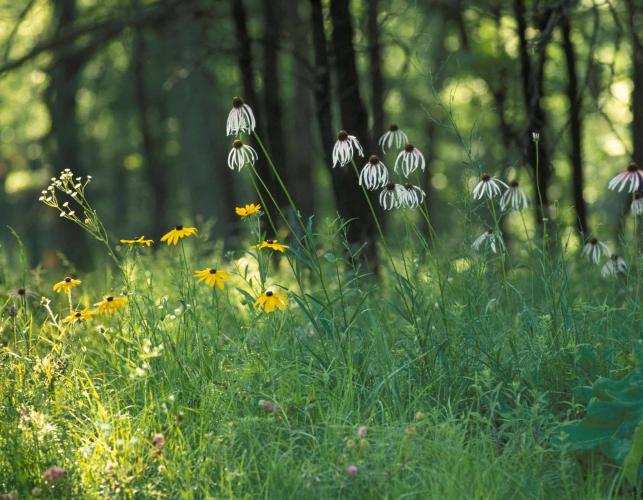
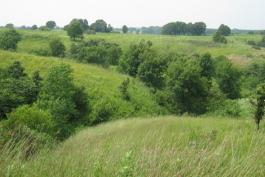
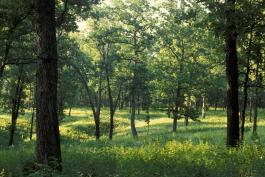


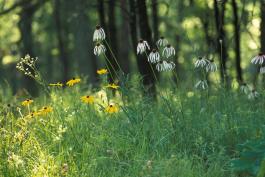
Key species


